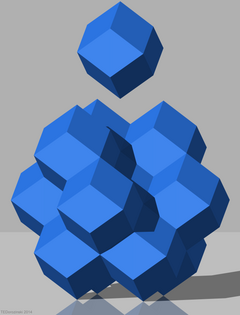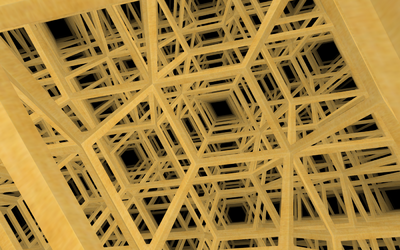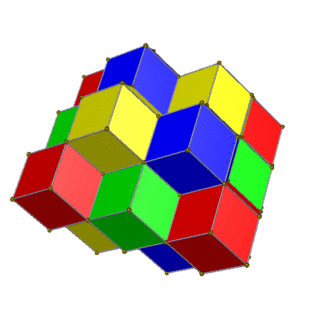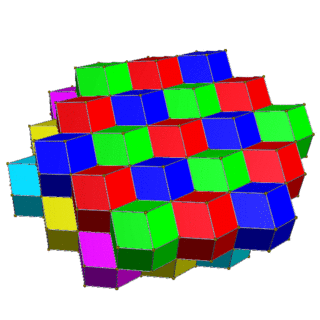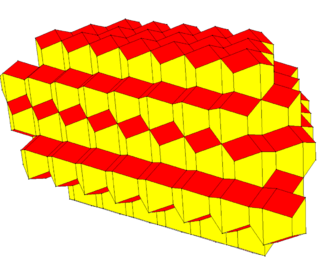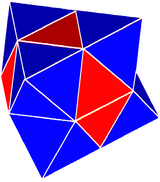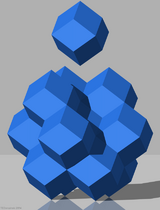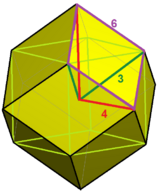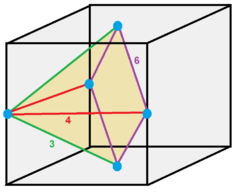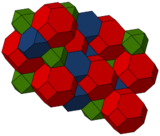Rhombic dodecahedral honeycomb
| Rhombic dodecahedral honeycomb | |
|---|---|
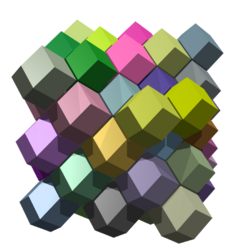
| |
| Type | convex uniform honeycomb dual |
| Coxeter-Dynkin diagram | |
| Cell type |  Rhombic dodecahedron V3.4.3.4 |
| Face types | Rhombus |
| Space group | Fm3m (225) |
| Coxeter notation | ½[math]\displaystyle{ {\tilde{C}}_3 }[/math], [1+,4,3,4] [math]\displaystyle{ {\tilde{B}}_3 }[/math], [4,31,1] [math]\displaystyle{ {\tilde{A}}_3 }[/math]×2, <[3[4]]> |
| Dual | tetrahedral-octahedral honeycomb |
| Properties | edge-transitive, face-transitive, cell-transitive |
The rhombic dodecahedral honeycomb (also dodecahedrille) is a space-filling tessellation (or honeycomb) in Euclidean 3-space. It is the Voronoi diagram of the face-centered cubic sphere-packing, which has the densest possible packing of equal spheres in ordinary space (see Kepler conjecture).
Geometry
It consists of copies of a single cell, the rhombic dodecahedron. All faces are rhombi, with diagonals in the ratio 1:√2. Three cells meet at each edge. The honeycomb is thus cell-transitive, face-transitive, and edge-transitive; but it is not vertex-transitive, as it has two kinds of vertex. The vertices with the obtuse rhombic face angles have 4 cells. The vertices with the acute rhombic face angles have 6 cells.
The rhombic dodecahedron can be twisted on one of its hexagonal cross-sections to form a trapezo-rhombic dodecahedron, which is the cell of a somewhat similar tessellation, the Voronoi diagram of hexagonal close-packing.
Colorings
The tiling's cells can be 4-colored in square layers of 2 colors each, such that two cells of the same color touch only at vertices; or they can be 6-colored in hexagonal layers of 3 colors each, such that same-colored cells have no contact at all.
Related honeycombs
The rhombic dodecahedral honeycomb can be dissected into a trigonal trapezohedral honeycomb with each rhombic dodecahedron dissected into 4 trigonal trapezohedrons. Each rhombic dodecahedra can also be dissected with a center point into 12 rhombic pyramids of the rhombic pyramidal honeycomb.
Trapezo-rhombic dodecahedral honeycomb
| Trapezo-rhombic dodecahedral honeycomb | |
|---|---|
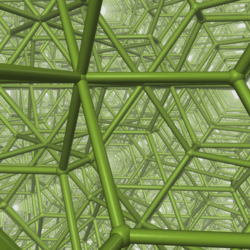
| |
| Type | convex uniform honeycomb dual |
| Cell type | trapezo-rhombic dodecahedron VG3.4.3.4
|
| Face types | rhombus, trapezoid |
| Symmetry group | P63/mmc |
| Dual | gyrated tetrahedral-octahedral honeycomb |
| Properties | edge-uniform, face-uniform, cell-uniform |
The trapezo-rhombic dodecahedral honeycomb is a space-filling tessellation (or honeycomb) in Euclidean 3-space. It consists of copies of a single cell, the trapezo-rhombic dodecahedron. It is similar to the higher symmetric rhombic dodecahedral honeycomb which has all 12 faces as rhombi.
Related honeycombs
It is a dual to the vertex-transitive gyrated tetrahedral-octahedral honeycomb.
Rhombic pyramidal honeycomb
| Rhombic pyramidal honeycomb | |
|---|---|
| (No image) | |
| Type | Dual uniform honeycomb |
| Coxeter-Dynkin diagrams | |
| Cell | rhombic pyramid |
| Faces | Rhombus Triangle |
| Coxeter groups | [4,31,1], [math]\displaystyle{ {\tilde{B}}_3 }[/math] [3[4]], [math]\displaystyle{ {\tilde{A}}_3 }[/math] |
| Symmetry group | Fm3m (225) |
| vertex figures | |
| Dual | Cantic cubic honeycomb |
| Properties | Cell-transitive |
The rhombic pyramidal honeycomb or half oblate octahedrille is a uniform space-filling tessellation (or honeycomb) in Euclidean 3-space.
This honeycomb can be seen as a rhombic dodecahedral honeycomb, with the rhombic dodecahedra dissected with its center into 12 rhombic pyramids.
Related honeycombs
It is dual to the cantic cubic honeycomb:
See also
References
- Williams, Robert (1979). The Geometrical Foundation of Natural Structure: A Source Book of Design. Dover Publications, Inc. p. 168. ISBN 0-486-23729-X.
External links
- Weisstein, Eric W.. "Space-filling polyhedron". http://mathworld.wolfram.com/Space-FillingPolyhedron.html.
- Examples of Housing Construction using this geometry
 |
